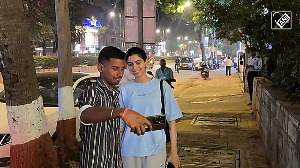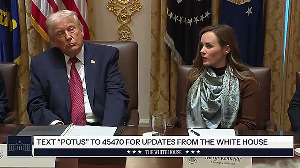
If the American president sneezes, the whole world gets to know," says P S Goel, director, Satellite Centre, Indian Space Research Organisation. "But if India launches a GSLV (geosynchronous satellite launch vehicle), I don't know whether it is even reported in the American press. Sadly, when we visit the US, we still have people asking us, 'Oh, you actually make satellites in India?' "
After India refused to sign the Missile Control Technology Regime over a decade ago, the US government imposed some fairly harsh economic sanctions on the Indian space programme. But "after an estrangement of a few years, we are back together again," says Dr Marco di Capua, counsellor for science, environment and technology in the US embassy in New Delhi.
Three years ago, when ISRO launched its first GSLV, then chairman Dr K Kasturirangan told rediff.com: "The American economic sanctions that we are still under impose certain limitations on us that prevent ISRO from working as closely with American space agencies as we would like to. Certainly we have maintained a level of contact with NASA [the National Aeronautics and Space Administration] and NOAA [the National Oceanic and Atmospheric Administration] and we have a programme of sending them INSAT data and meteorological data. We are also constantly in touch with senior NASA scientists, and hope that things will improve soon."
Soon after he said that, and the GSLV was launched, then prime minister Atal Bihari Vajpayee and US President George W Bush issued a joint statement that both sides would discuss ways to stimulate bilateral high-technology commerce and civil space cooperation.
Soon other agencies like the American Institute of Astronautics and Aeronautics, the Astronautical Society of India, and the Indo-US Science and Technology Forum pitched in and pushed the two countries towards holding a conference in India to formalise this cooperation.
The end result was the four-day India-US Conference on Space Science, Applications, and Commerce, which began in Bangalore yesterday. It has been organised by the ASI and the AIAA, and sponsored by ISRO, the Indo-US Science and Technology Forum, NASA, NOAA, and the American government itself.
This conference is the first serious bilateral engagement on space cooperation between India and the US, though the history of cooperation in space activities between the two countries dates back 40 years.
As this conference is largely a goodwill exercise meant to formalise the revival of Indo-US space ties, it includes public outreach programmes like lectures by astronauts and space scientists.
The late Kalpana Chawla's husband is among those visiting India for this conference. But some key people, like Department of Space and Technology Secretary V S Ramamurthi, and some senior NASA officials, could not make it, giving rise to rumours that this conference would not carry the punch it was meant to after all. Both di Capua and Nair, however, insist that these absences were caused by unavoidable prior engagements.
Specific topics identified for discussion include satellite communications technology and applications, satellite navigation and applications, space science, earth observation science, technology and applications, natural hazards research, disasters, and space commerce.
Indo-US cooperation in space dates back to the start of the Indian space programme. The Thumba Equatorial Rocket Launching Station established in the early 1960s received assistance from the US in the form of equipment and sounding rockets for carrying out scientific experiments. The very first sounding rocket launched from Thumba in 1963 was a US-made Nike-Apache that carried instruments to conduct ionospheric experiments over the earth's magnetic equator. NASA trained ISRO's earliest young recruits like R Aravamudan and A P J Abdul Kalam.
When India conducted the Satellite Instructional Television Experiment in the mid-1970s, NASA actually moved its satellite, the ATS-6, over the Indian Ocean. Then again, India became one of the first countries to receive remote-sensing data from a NASA satellite, and to learn how to process and apply it. This, in turn, helped India to design and build its own remote-sensing satellites.
All this came to a standstill when the US government imposed economic sanctions on India. The US even compelled Russia to backtrack on its deal with India to transfer technology to manufacture cryogenic engines.
But ISRO has managed to keep its space programme going at the same pace. "ISRO programmes were never seriously affected by the sanctions," says chairman G Madhavan Nair. "However, we are happy to note that now the dialogue with the US has reached a point where we have changed from presuming that any requests for components or technologies in the area of space will be turned down to presuming that they will be approved! Many parts we need have been removed from the banned list now."
Now that the estrangement is over, di Capua says the US will definitely foster civilian space cooperation and high-technology trade. "This conference is a watershed for Indo-US space relations," he says warmly. "We are now coming together big-time."
Why this sudden change of heart? "It is part of the transformation of the Indo-US relationship in general," says di Capua. "We recognise that India is now an important force in Asia, and also that it has a larger presence in the US, in terms of technology, commerce, and people; there are two million Indians in the US now!"
Besides, he says, the Indian space programme has matured over the years. "It is time we know each other again," he says. "Besides, NASA is under strong examination after the [Columbia] space shuttle disaster. India has a great advantage in developing software and data analysis. Also, ground augmented satellite systems are very good in India."
Adds Nair: "Our two countries complement each other perfectly in the area of space. We have a very cost-effective programme that the US can really benefit from. And there are several items we need for satellite manufacture where the volumes required are too small to justify production here. We can now just import those from the US. The opening up of the US gives India a competitive advantage in sourcing components."
"We want industries in the area of space in both countries to begin working with each other," says Satellite Centre director Goel.
The expected outcome of the conference is to chart out suggestions for future bilateral cooperation and commerce between the two countries. It is hoped that the suggestions will help establish a direction for renewed bilateral space cooperation. This should hopefully lead to joint projects between US and Indian space scientists, engineers, industry leaders, and policymakers.
All the big names of the American space industry, such as Boeing, Panamsat, Intelsat, Raytheon, Honeywell, Loral and Space Imaging are in Bangalore for the show. "Please don't expect digital results from this conference," quips Goel. "We are just trying to create the right atmosphere for cooperation, that's all."





